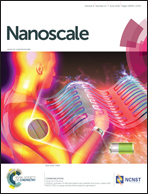Highly stable microwave susceptible agents via encapsulation of Ti-mineral superfine powders in urea-formaldehyde resin microcapsules for tumor hyperthermia therapy
Abstract
In this study, Ti-mineral superfine powders (Ti-MSP) encapsulated in urea-formaldehyde resin microcapsules (Ti-MSP@UF-MC) were successfully prepared via a one-step microemulsion method for the first time. Because of the strong confinement effects, the Ti-MSP@UF-MC possessed perfect microwave heating effects. The temperature was 9.3 °C higher than that of the saline solution, superior to UF-MC (no significant microwave heating effect, 0 °C) and Ti-MSP (5.1 °C). The Ti-MSP@UF-MC showed low toxicity and good biocompatibility via a series of studies, including a hemolysis study and the MTT assay in vitro and in vivo. When the concentration was below 1000 μg mL−1, the hemolysis rate was lower than 5% (hemolysis study). When the concentration was below 400 μg mL−1, the cell activity was higher than 80% (MTT assay). Moreover, the Ti-MSP@UF-MC exhibited an ideal CT imaging effect in vivo owing to the large molecular weight of Ti-MSP. The Ti-MSP@UF-MC showed a favorable microwave therapy effect in vivo. Using mice bearing H22 tumor cells as an animal model, the tumor suppression rate could reach 100%.


 Please wait while we load your content...
Please wait while we load your content...